The NVIDIA GeForce GTX 1070 Ti Founders Edition Review: GP104 Comes in Threes
by Nate Oh on November 2, 2017 9:00 AM EST- Posted in
- GPUs
- GeForce
- NVIDIA
- Pascal
- GTX 1070 Ti
Compute
Shifting gears, let’s take a look at compute performance on the GTX 1070 Ti.
As the GTX 1070 Ti is another GP104 SKU – and a fairly straightforward one at that – there shouldn’t be any surprises here. Relative to the GTX 1070, all of NVIDIA's performance improvements actually favor compute performance, so we should see a decent bump in performance here. However it won't change the fact that ultimately the GTX 1070 Ti will still come in below the GTX 1080, which has more SMs and a higher average clockspeed (never mind the benefits of more memory bandwidth).
Starting us off for our look at compute is Blender, the popular open source 3D modeling and rendering package. To examine Blender performance, we're running BlenchMark, a script and workload set that measures how long it takes to render a scene. BlechMark uses Blender's internal Cycles render engine, which is GPU accelerated on both NVIDIA (CUDA) and AMD (OpenCL) GPUs.
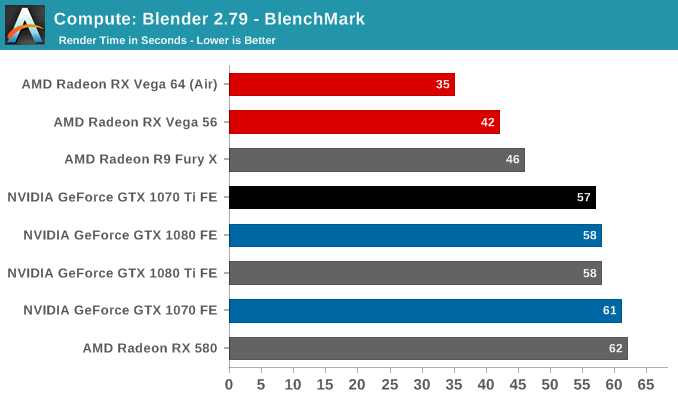
As you might expect, the GTX 1070 Ti's performance shoots ahead of the GTX 1070's due to the additional enabled SMs of this new video card SKU. In fact it technically outpaces the GTX 1080 by a single second, which although eye-popping, is within our margin of error. However what it can't do is overtake AMD's lead here, with the NVIDIA cards trailing the Vega family by quite a bit.
For our second set of compute benchmarks we have CompuBench 2.0, the latest iteration of Kishonti's GPU compute benchmark suite. CompuBench offers a wide array of different practical compute workloads, and we’ve decided to focus on level set segmentation, optical flow modeling, and N-Body physics simulations.
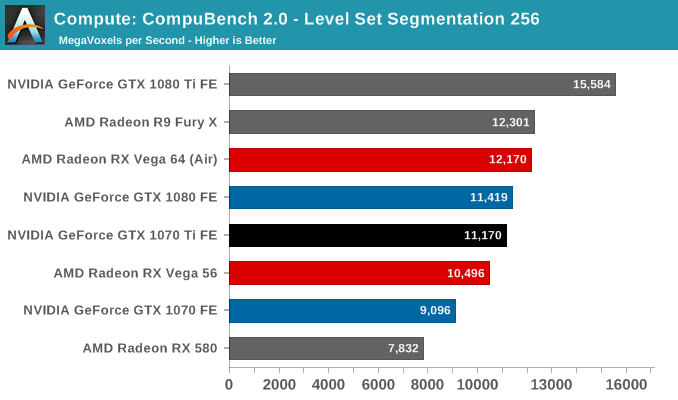

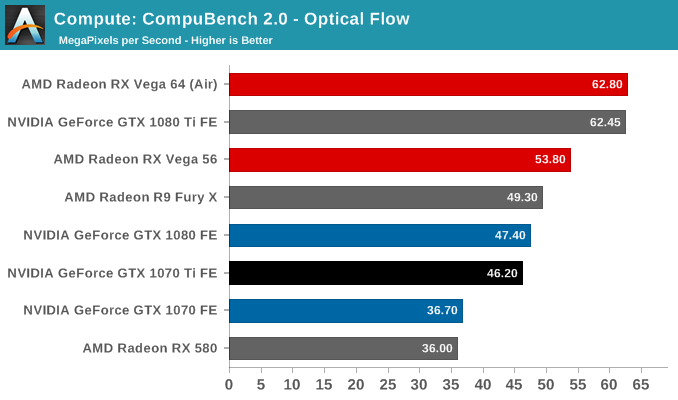
In all 3 sub-tests, the GTX 1070 Ti makes modest gains. Overall, performance is now quite close to the GTX 1080, which makes sense given the relatively small gap in on-paper compute performance between the two cards. This also means that at least in the case of these benchmarks, the lack of additional memory bandwidth isn't hurting the GTX 1070 Ti too much. However looking at the broader picture, all of the NVIDIA GP104 cards are trailing AMD's Vega family outside of the more equitable level set segmentation sub-test.
Moving on, our 3rd compute benchmark is the next generation release of FAHBench, the official Folding @ Home benchmark. Folding @ Home is the popular Stanford-backed research and distributed computing initiative that has work distributed to millions of volunteer computers over the internet, each of which is responsible for a tiny slice of a protein folding simulation. FAHBench can test both single precision and double precision floating point performance, with single precision being the most useful metric for most consumer cards due to their low double precision performance.
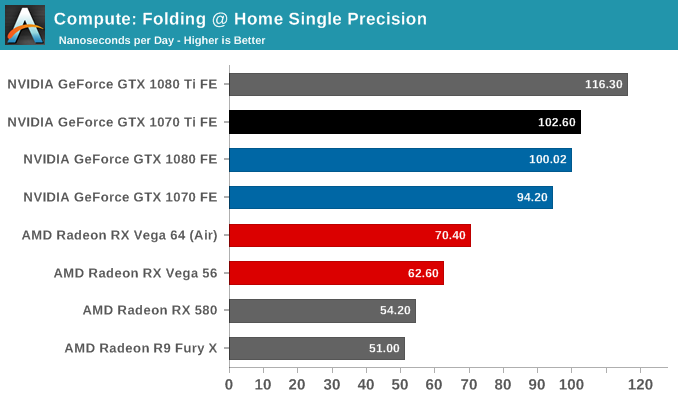
The GTX 1080 and GTX 1070 were already fairly close on this benchmark, so there's not a lot of room for the GTX 1070 Ti to stand out. Interestingly this is another case where performance actually slightly exceeds the GTX 1080 – though again within the margin of error – which further affirms just how close the compute performance of the new card is to the GTX 1080.
Our final compute benchmark is Geekbench 4's GPU compute suite. A multi-faceted test suite, Geekbench 4 runs seven different GPU sub-tests, ranging from face detection to FFTs, and then averages out their scores via their geometric mean. As a result Geekbench 4 isn't testing any one workload, but rather is an average of many different basic workloads.
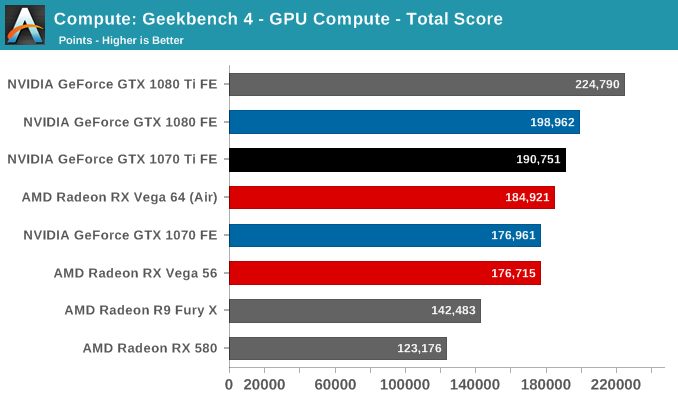
As with our other benchmarks, the GTX 1070 Ti more or less bridges the gap between the GTX 1080 and GTX 1070, falling just a few percent short of the GTX 1080 in performance. This is a test where NVIDIA was already doing better than average at, and now with its increased SM count, the GTX 1070 Ti has enough compute performance to surpass AMD's RX Vega 64, something the regular GTX 1070 could not do.










78 Comments
View All Comments
CiccioB - Thursday, November 2, 2017 - link
Price is dictated by the basic market supply/demand rule.Being a so basic rule, I can't understand why people continuously whine about too high prices.
Do you think you are better than the entire nvidia marketing team?
Do you think that lowering the prive as you suggest is going to make nvidia gain more money?
kmmatney - Thursday, November 2, 2017 - link
Why should our goal be to make NVidia more money?nyquaxyla - Thursday, November 2, 2017 - link
Why should Nvidia's goal be to make any less money than the most that they can make?I'm not saying that I like this system.. I too wish there was more competition from AMD, and GPU prices were lower.. but the harsh reality is that profits are the ultimate decider, and every business will try to maximize the same.. it doesn't make them bad or evil people.
darckhart - Thursday, November 2, 2017 - link
Come on, this card shouldn't even exist. Only because miners have created supply shortages has NV decided to put another something out there. It's purely a cash grab. 1 less SM than a 1080? No factory overclocks because it could cannibalize 1080 sales? The only people looking for new 1080s are probably miners once again. And compete against Vega56? Come on. No one can GET a Vega56 at MSRP.CiccioB - Friday, November 3, 2017 - link
You are getting it wrong.People here whine about how the things should work and indeed they work that way.
Companies exists to make money (rule number one companies based on capitals) and whining because they try to make more of them is quite useless like whining about the fact that if you leave your smartphone it will fall down.
So constantly speaking about wrong or right prices from OUR point of view is useless and quite stupid. I can't see people whining about the fact that the gravity is too high and that falling smartphones can't be grabbed before they touch the ground.
They are basic rules that makes things work (one the economics, the other one the universe) so it is really useless to point about wrong prices. People have learnt that whining about gravity won't change the effects, but it appears that they have still not understood that good prices is a simple supply/demand affair.
We all would like a GTX1080/Vega to cost $50 and that smartphones would not fall so fast, but that is our vain wish, not what can be either possible or even clever to discuss on a technical forum like this one. More if you do not understand economics.
kmmatney - Friday, November 3, 2017 - link
These cards are marketed to gamers. However the "demand" (what is driving up the price) is not from gamers, it's from miners. So the high prices are artificial - if miners weren't snapping up all the cards, they would be lower. Heck, the cards can't even get down to MSRP - we can at least complain about that. At least I bought my 1060 at MSRP, and it is still good enough for now.babadivad - Thursday, November 2, 2017 - link
I still think the Vega 56 is the best value card out there. Granted you can find one.Samus - Thursday, November 2, 2017 - link
I was at Microcenter a month ago when the Vega56 was just becoming available at retail, and this guy was talking to the sales clerk about how it's his fifth one for mining and I just wanted to punch him. He'd apparently been coming back to the store repeatedly to buy them all.That's why I can't find any fucking video cards to upgrade my GTX970/980. And considering it still plays everything (albeit at medium detail in some stuff) I'm just going to ride this GPU gravy train out.
tipoo - Thursday, November 2, 2017 - link
Just when they reach a point of convergent evolution with Intel designs, they seem to slip away on GPUs. Maybe AMD just can't sustain three tentpolls (counting APUs) at once? Spin-out?
Nvidia is spending 3 billion on each new architecture (and in that cost, spliting compute architectures from gaming architectures), while AMD I don't think is even hitting the big B on new architectures, and keeping one for both sides. Too bad, but no wonder results are like this.
Anyways, per the 1070TI, I don't suppose the MRSP will be anywhere near realistic for a while as eth miners are still snapping up any good cards.
Manch - Thursday, November 2, 2017 - link
AMD doesn't have a 1080TI fighter, cant compete on efficiency, and the cards came too little too late. It wasn't enough to match year old cards, they needed to beat them. Miners are their only saving grace right now.That being said, there were some design choices made with integration in mind ala RR, and I think it will pay off in the long run but it wont move cards into gamers hands right now.
Asf or the 1070TI, I don't see the point but I get why NVidia is doing it. Adds an option, crowds out the 56, gives them something to do with those other chips.
IF they actually sell at what they're supposed to sell at, I don't see why you wouldn't spring for the 1080. Price/Perf diff isn't worth the savings when spending that much.